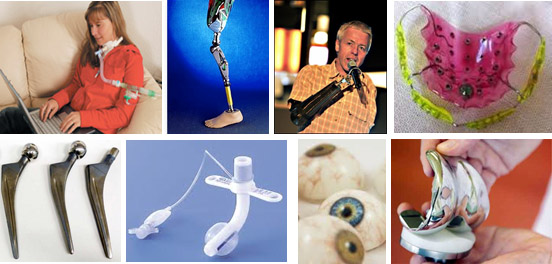Biomaterials and Healthcare - Eksperter i team
Biomaterials and Medical Devices: Body Parts of the Future
As people live ever longer, the use of artificial body parts and other medical or assistive devices is becoming more and more common. There is, however, a lack of good products and solutions.
Increased use of medical devices and other health related equipment is in many cases associated with an increased risk of functional failure, as well as other complications, i.e. problems related to material degradation and/or “bad design”. As a result, there is today a need for new technologies that can provide medical devices with improved properties and/or function, as well as new medical aid solutions increasing the quality of life of the people/animals in need of help in different ways.
Even within Paralympic equipment, there are few really good solutions, and customization of the equipment to each individual is often required.

Relevant competency
This is a theme where engineering (most disciplines), health professions (medicine, physiotherapy, motion, etc) and humaniora all go together if good solutions are to be found.
About the village
In the Biomaterial Village a medical device and/or equipment is considered to be an instrument, apparatus, implant, in-vitro reagent, or similarly related article that is used to diagnose, prevent, or treat diseases and conditions in humans/animals, but that does not achieve its purposes through chemical action within or on the body, i.e. the device should act by other behaviors like physical, mechanical, or thermal means.
Today, medical devices and/or equipment vary greatly in complexity and application, and product manufacturing is a long process requiring robust standard operating procedures and guidelines for production. With global competition, the R&D of new biomedical devices/equipment is not just a necessity, but it is imperative for the production of innovative and up-to-date solutions. The realization of a new design can be very costly, especially with the shorter product life cycle. In this regards, it should not be forgotten that as technology advances there is a level of quality, safety and reliability that increases exponentially with market demands.
The Biomaterials Village is looking for student interest in medical devices and equipment for use in human and veterinary medicine, with the goal to improve quality of life through material technology and product design. The goal of the village is to work on real world problems, and to turn ideas into simple designs and solutions that can make a difference.
With guidance from the village supervisor’s team efforts will be made to find valuable solutions to important issues related to medical devices and equipment used to improve health related quality of life for both humans and animals, as well as equipment to be used by disabled professionals and amateurs during different sport activities. Effort should be made to find the best possible role for each team member, to arrange excursions to hospitals/ veterinary clinics, research institutes, and/or implant/device manufacturers, as well as to work closely together with medical/veterinarian personal on all levels to try to identify what is in store for the future of medical devices and equipment.
In the Biomaterial Village the students will have the opportunity to work with topics that are relevant to NTNU's strategic area Health.
Course code: TMM4852
Village: Biomaterials
Type: Semester-based
Language: English
Village supervisors: Knut Aasland
Semester: Spring 2019
Important information about EiT:
- The focus on teamwork skills and group processes is the unique feature of Experts in Teamwork (EiT)
- EiTs teaching methods depend on the contribution and presence of every participant throughout the semester. For this reason, attendance is compulsory on every village day.
- In contrast to many courses, the first few days are especially important in EiT. During this period, get to know each other and discuss what each individual can contribute. You will also draw up the compulsory cooperation agreement and start preparing a shared research question.
- For additional information about Experts in Teamwork, see page for students
